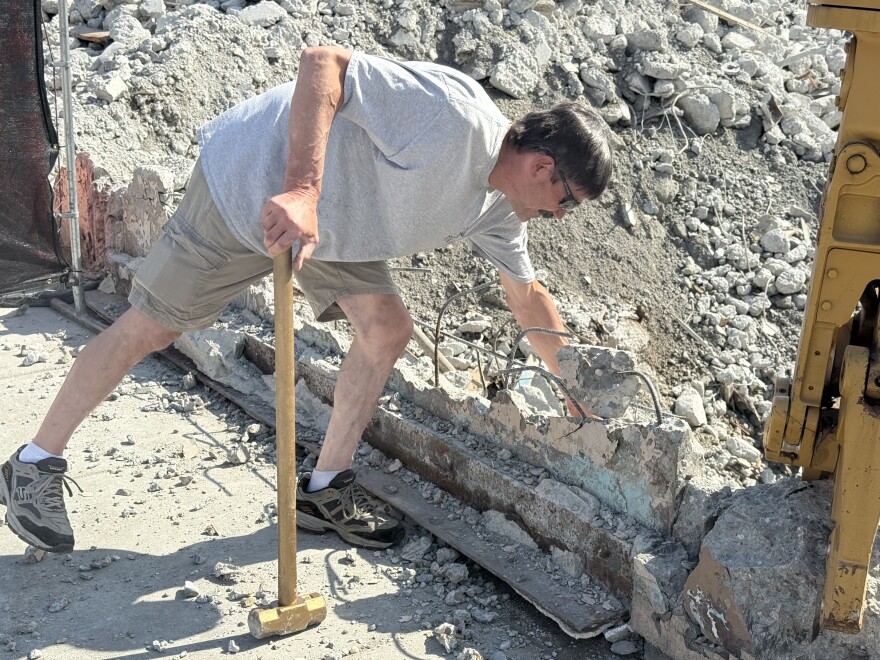The usual suspects headlined Golden Days festivities in Fairbanks on Saturday.
Floats snaked through the heart of town in the parade. The Chena River carried thousands of rubber duckies in their annual race for glory. And myriad vendors and performers lined the street and filled Golden Heart Plaza.
By comparison, the shin-high, crumbly bit of wall – with metal rods poking out the top, like bad bedhead – looked pretty unimpressive.
But it did manage to attract some attention to its spot at the corner of First Avenue and Lacey Street, that is, once sledgehammers got involved.
In exchange for a donation to the local food bank, event-goers could wield a gold-colored hammer, pitting themselves against the vestige of the 73-year-old Polaris Building. One at a time, people lifted the arm-length tool, whipping it forward in what often resembled a wild golf swing.
“[I] wanted to be a part of it. It’s really cool that they have this out here, and it’s cool to be a part of the demolition of this,” Jessie Vorves said.
He described his attempts as primarily “instructional” for his two children: Cody and Jessie Jr.
“I’m trying to show them how to dress up their swing a little bit,” their father said.
The Vorves kids put the lesson to work. While they didn’t immediately succeed in breaking off a piece, they wore determined expressions as they pounded on the wall repeatedly to the sound of their father’s encouragement and the clanging of hammer on concrete.
“The metal is in the way,” Cody Vorves announced soon before handing the hammer to his brother, referring to the bent rods that some bits of concrete were still clinging to.
A few minutes later, Scott Clayton stepped up. He’s worked at the towing company across the street from the Polaris Building for 30 years. He smashed off some chunks with ease, but before walking away, Clayton, like others before him, leaned over to pick up a souvenir.
What was he holding?
“A piece of the Polaris Building,” Clayton said.
And how’d he get it?
“I beat it off the wall,” he added.
Clayton brought home a small piece of a wall, but also a small piece of Fairbanks history. The 11-story Polaris Building once stood as a proud centerpiece of downtown. But the highrise was abandoned after flooding in the early 2000s, and the deteriorating structure earned a reputation as a public nuisance that marred the city’s modest skyline.
So Saturday’s citizen demolition of part of the structure’s final wall was clearly more a symbolic moment than a functional one – an opportunity for people to release frustration they may have built up while waiting for the building to come down.
Fairbanks Mayor David Pruhs, who organized the sledgehammering, also took some swings Saturday. And he said doing so felt “climactic.”
“You know, it’s Golden Days, and I just wanted the City of Fairbanks to come here and look at this one more time and take a few whacks at it and say goodbye,” Pruhs said.
The other phases of the deconstruction process required more than a few whacks.
First came securing about $10 million in federal funding and $3 million in state funding in 2022 and 2023, respectively. The city then contracted Coldfoot Environmental Services to complete the demolition, which also involved shipping contaminants found in the building to the Lower 48. The project was originally scheduled to end last October, but the city had to extend the deadline by a year.
That meant two summers of drivers needing to navigate detours due to road closures near the site. It also meant nearby business owners having to endure the noise and access issues that came with being right next to the major deconstruction project.
So each crack of the sledgehammer Saturday helped ring in a possible turning point for the city’s downtown core. Yet the visible fencing, heavy machinery and piles of rubble also served as a counterpoint – a reminder that there’s a lot of work to do, with the future of the city-owned site still undetermined.
“It’s public property, so we want to give a good timeframe for a good plan for whoever wants to do this,” Pruhs said.
Pruhs said he expects to release a request for proposals within a month that will stay open to submissions for six months.
“It’s not gonna be rushed. It’s not gonna be given away. It will be earned,” he said.
Regardless of what’s built next at the site, the pressure will be on for any development avoid the fate of its predecessor. And if it doesn’t, the Vorves brothers might not mind another opportunity to practice their swing.


